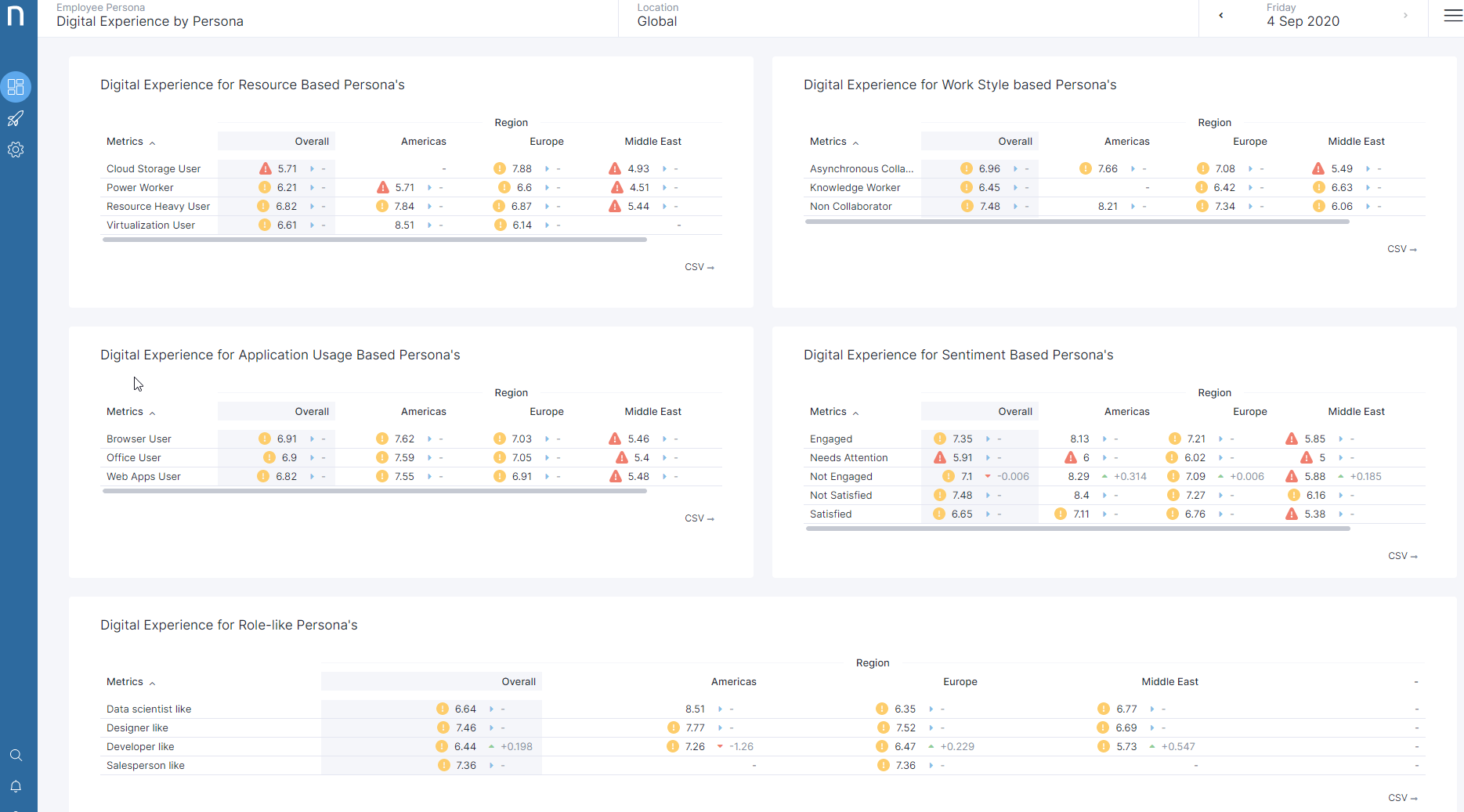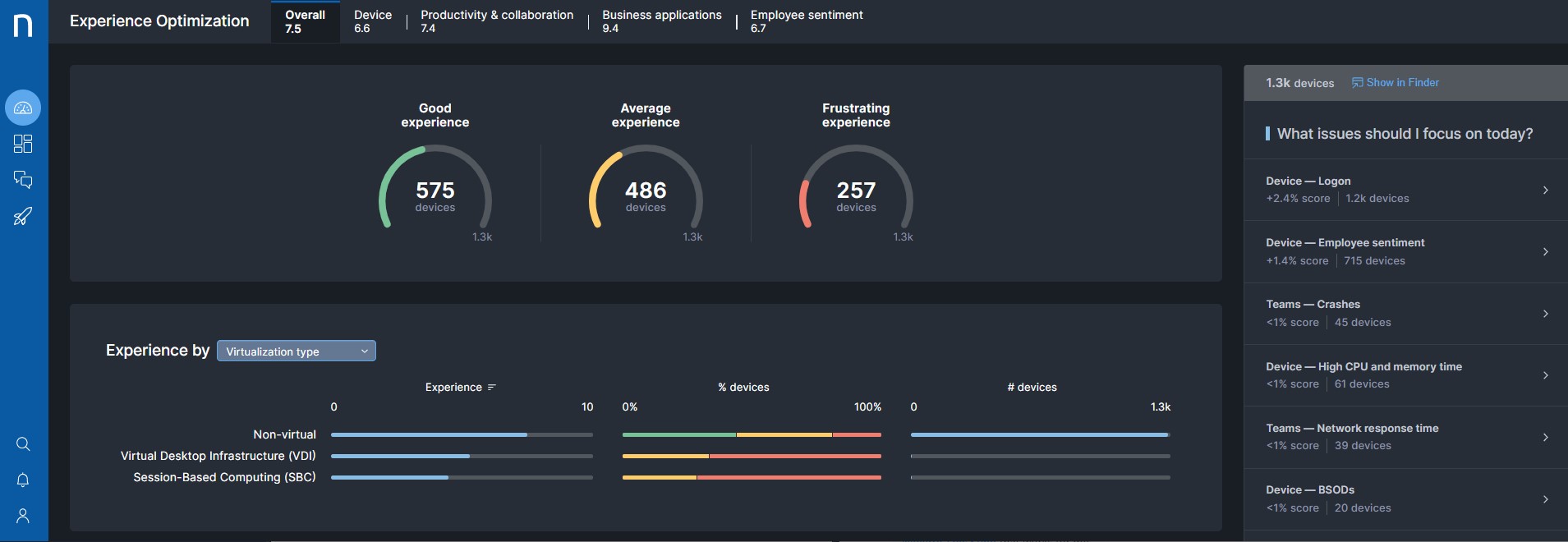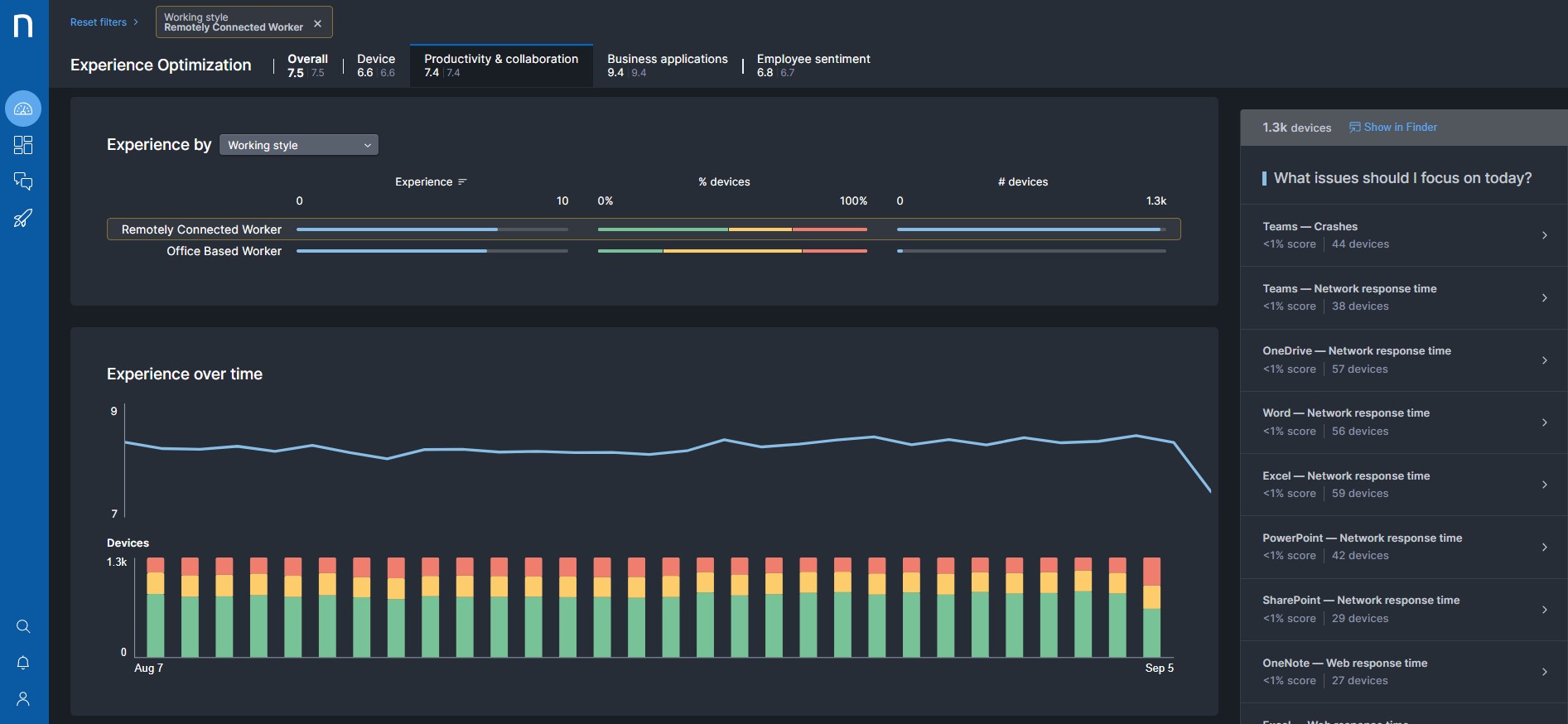Personalized Experience at the Right Cost
With our recent product release, Nexthink brings the power of personalized, right-sized IT to customers, allowing them to deliver the right services, at the right cost to every workforce role.
Delivering personalized and right-sized IT services is only possible when organizations understand the technology needs of employees and, to help our customers, Nexthink has delivered powerful new capabilities. Persona Insight is a new Library Pack that helps organizations deliver the right virtual and physical resources to employees and continually improve their digital employee experience. Nexthink customers can go beyond department titles to more granularly understand the needs of workforce roles. For example, in a large software development organization, there may be front-end developers, full-stack developers, QA engineers, DevOps engineers, and security engineers. If a company takes a one-size-fits-all approach to resource provisioning, everyone in the development org might get the same software and hardware, even though their needs are vastly different from one role to the next. By tailoring IT resources to each workplace role (or persona), IT delivers a better digital experience to the entire workforce, while achieving cost savings by avoiding any overprovisioning of resources.
Another value proposition of Persona Insight’s ability to measure resource requirements is that this data can inform IT which roles are well suited for physical laptops, virtual desktops (VDI), or session-based computing (SBC). This allows IT to right-size budget spend while providing the right IT services.
For those workforce roles that are well suited to virtualization, the migration from physical to virtual must be properly managed. Virtualized desktop projects, both VDI and SBC, are complex and risk-filled undertakings. To address this, Nexthink has also announced new virtualization experience management capabilities built to deliver value across the entire virtualization lifecycle, from assessment to pilot and ongoing operations.
Finally, the delivery of employee-centric IT requires that experience management be integrated into existing IT ecosystems and workflows. For this Nexthink has announced new integration capabilities as well. Read on to learn more:
Persona Insight – deliver employee-centric IT services
Persona Insight lets IT professionals deliver role-optimized resources driven by deep insights about workforce needs, rather than broad assumptions that create employee frustration and wasted IT spending. IT is now able to make better informed choices about the computing resources for each role: physical machines, virtual desktops, and/or desktops and applications delivered via session-based computing, as well as the specific applications for each role.

Digital Experience by Persona
When it comes to understanding the different workplace roles that exist, many organizations either don’t try, or for those that do, they often don’t get any more granular than HR-defined departmental roles. The reality however is this is typically too broad a brush stroke to be truly valuable. As an example, within any department (marketing, sales, engineering, etc.) there are many different roles, and those roles can require significantly different computing resources. To look at marketing for example, the graphics team may be considered super-users with heavy compute and memory requirements, while marketing operations works heavily with cloud-based marketing technology tools requiring far fewer local compute resources.
“Employees consume a diverse and complicated set of IT services to accomplish their jobs,” said Belinda Schouten, Grid Owner, Digital Workplace, ABN AMRO. “With Nexthink, we start with the employee and understanding their needs. This empowers our team to proactively identify, remediate, and prevent fluctuations in employee experiences versus making assumptions based on a collection of technical data and having to reactively troubleshoot.”
With Persona Insight, IT can measure and quantify the workforce requirements of these different roles, and then armed with that information, IT can right-size the computing platform and applications, while optimizing the associated cost – to make sure the entire workforce is successful.
Further, it’s not enough to simply baseline technology requirements once for each role. Organizations must also monitor requirements over time to ensure resources stay aligned. The one constant at any company is change. New applications, tools, and workflows are brought into the business, and individuals’ responsibilities and roles change as well. Persona Insight allows IT to understand these dynamics so they can stay ahead of the needs of employees.
“
Persona Insight offers a data-driven approach to understanding how employees engage with technology and what they need to be productive. Armed with this knowledge, IT can deliver the right services, at the right cost, to each employee

Pedro Bados
CEO and Co-founder of Nexthink
Expanded Virtualization Experience Management for the Entire Project Lifecycle
New virtualization experience management capabilities help organizations deliver the right virtual and physical resources to employees and continually improve the digital experience they receive. Real-time visibility and measurement of employee sentiment addresses the number one risk to project success – lack of timely understanding of employee experience and issues. These new capabilities deliver value throughout the entire lifecycle of desktop virtualization projects from assessment through ongoing operations, whether deploying Citrix, Microsoft Windows Virtual Desktop (WVD), or VMware Horizon.
As discussed earlier, in order to provide the right services, at the right cost, to every workforce role, organizations must provide and support a variety of end-user platforms, both on-premises as well as in the cloud. For organizations that want one solution to measure and manage digital experience across both physical and virtual environments – correlated with employee sentiment for full visibility – Nexthink is the only option.

Desktop Experience by Platform Type (Physical, VDI, and SBC)
Rather than a typical piecemeal approach where multiple vendors’ products are needed, Nexthink delivers a single solution for IT to manage the entire lifecycle of their desktop virtualization projects across Citrix, Microsoft WVD, and VMware Horizon:
- Assessment phase – Organizations can perform capacity planning, quantify CPU requirements, and understand memory needs.
- Pilot – IT can proactively measure employee experience and quantify employee sentiment before and during pilot projects to ensure that the experience is as good as, or better than, it was prior to the migration.
- Operational phase – IT must ensure that employee experience is continuously optimized through real-time monitoring and troubleshooting. Common issues that cause experience problems (and must be closely monitored) are application load times, application response times, session response times, logon duration, graphics quality and responsiveness, and connectivity issues.

Virtual Desktop Experience Trending
Expanded Integrations to Make IT More Flexible & Resilient
Our new expanded integrations help IT to pull in Nexthink’s key Digital Employee Experience (DEX) data for their most prized ITSM tools. Integrations with technologies like ServiceNow make it easier for IT to quickly pivot, identify employee issues, and speed up their resolution times. In addition, our new Azure Data Lake Storage integration can be used to populate third-party business analytics services such as Power BI. These integrations empower IT teams to create highly configurable dashboards and access experience-centric insights that ultimately help them to better support their digital transformation projects.
Azure Data Lake Storage integration
Many IT departments use Azure Data Lake Storage (ADLS) as an essential data repository and analytics service, allowing them to store important data and insights in a single place. This data can then be pushed and consumed in countless different ways to combine, visualize and make sense of raw data. Nexthink allows users to send Nexthink real-time analytics to ADLS Gen2 in a highly configurable way for consumption in preferred external sources. This allows IT teams to collect and consume vital experience-level data around devices, networks, applications, and more to gain a deeper level of understanding for specific IT or business scenarios. As an example, a common ADLS use case is sending data to Power BI for analysis.
Microsoft Power BI
By pulling the required data from ADLS—pushed and configured using the event connector— IT teams can create personalized management dashboards and combine different data sources.
One of our more recent examples is with the combination of Microsoft and Nexthink data to gain deeper, actionable insight into MS Teams call quality across the enterprise. In these times of large-scale remote working, such dashboards can provide additional, much-needed visibility into the technical performance and employee experience of a critical collaboration tool to proactively improve workforce wellbeing and satisfaction.
In Summary
For organizations to successfully deliver personalized and right-sized IT services, they need three important capabilities:
- They must be able to measure and quantify the technology needs of employees. Traditionally, IT has made assumptions about employee requirements based on static, macro-level information such as business department. This arbitrary grouping of users lacks both data and insight, and in most cases, results in a significant reality gap.
- IT must understand the different performance characteristics of physical and virtual computing – both virtual desktop (VDI) and session-based computing (SBC) – and match those to the workplace needs of different roles. When IT can right-size desktop computing platforms for each role, they can reduce employee technology disruptions as well as cost to the business.
- IT must find an easy mechanism to integrate experience management data into their IT ecosystem to automate workflows and streamline troubleshooting and problem resolution.
Want to learn more?
Bob Noel, Director of Product Marketing, Nexthink
12 Tips to Help IT Support a Distributed Workforce
Allow your employees to work from anywhere and still maintain a productive digital experience
Related posts:
- Supporting Citrix Customers Through the Desktop Virtualization Lifecycle
- Your MS Teams Rollout Needs Specific Help—Not General Guidance
- What Your IT Chatbot Can Look Like Running on Full Power
- 8 Websites Every End-User Computing Professional Needs to be Visiting Daily